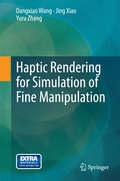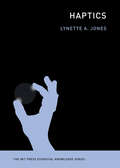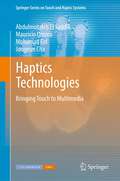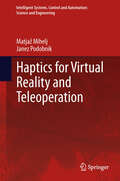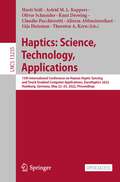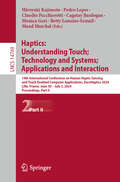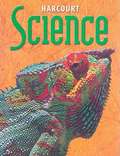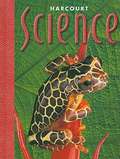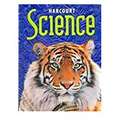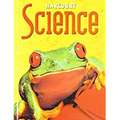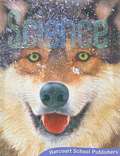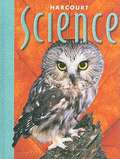- Table View
- List View
Haptic Rendering for Simulation of Fine Manipulation
by Dangxiao Wang Jing Xiao Yuru ZhangThis book introduces the latest progress in six degrees of freedom (6-DoF) haptic rendering with the focus on a new approach for simulating force/torque feedback in performing tasks that require dexterous manipulation skills. One of the major challenges in 6-DoF haptic rendering is to resolve the conflict between high speed and high fidelity requirements, especially in simulating a tool interacting with both rigid and deformable objects in a narrow space and with fine features. The book presents a configuration-based optimization approach to tackle this challenge. Addressing a key issue in many VR-based simulation systems, the book will be of particular interest to researchers and professionals in the areas of surgical simulation, rehabilitation, virtual assembly, and inspection and maintenance.
Haptic Teleoperation Systems
by Jae-Young Lee Shahram PayandehThis book examines the signal processing perspective in haptic teleoperation systems. This text covers the topics of prediction, estimation, architecture, data compression and error correction that can be applied to haptic teleoperation systems. The authors begin with an overview of haptic teleoperation systems, then look at a Bayesian approach to haptic teleoperation systems. They move onto a discussion of haptic data compression, haptic data digitization and forward error correction.
Haptics (The MIT Press Essential Knowledge Series)
by Lynette JonesAn accessible, nontechnical overview of active touch sensing, from sensory receptors in the skin to tactile surfaces on flat screen displays. Haptics, or haptic sensing, refers to the ability to identify and perceive objects through touch. This is active touch, involving exploration of an object with the hand rather than the passive sensing of a vibration or force on the skin. The development of new technologies, including prosthetic hands and tactile surfaces for flat screen displays, depends on our knowledge of haptics. In this volume in the MIT Press Essential Knowledge series, Lynette Jones offers an accessible overview of haptics, or active touch sensing, and its applications. Jones explains that haptics involves integrating information from touch and kinesthesia—that is, information both from sensors in the skin and from sensors in muscles, tendons, and joints. The challenge for technology is to reproduce in a virtual world some of the sensations associated with physical interactions with the environment. Jones maps the building blocks of the tactile system, the receptors in the skin and the skin itself, and how information is processed at this interface with the external world. She describes haptic perception, the processing of haptic information in the brain; haptic illusions, or distorted perceptions of objects and the body itself; tactile and haptic displays, from braille to robotic systems; tactile compensation for other sensory impairments; surface haptics, which creates virtual haptic effects on physical surfaces such as touch screens; and the development of robotic and prosthetic hands that mimic the properties of human hands.
Haptics Technologies
by Jongeun Cha Mauricio Orozco Mohamad Eid Abdulmotaleb El SaddikThe term "haptics" refers to the science of sensing and manipulation through touch. Multiple disciplines such as biomechanics, psychophysics, robotics, neuroscience, and software engineering converge to support haptics, and generally, haptic research is done by three communities: the robotics community, the human computer interface community, and the virtual reality community. This book is different from any other book that has looked at haptics. The authors treat haptics as a new medium rather than just a domain within one of the above areas. They describe human haptic perception and interfaces and present fundamentals in haptic rendering and modeling in virtual environments. Diverse software architectures for standalone and networked haptic systems are explained, and the authors demonstrate the vast application spectrum of this emerging technology along with its accompanying trends. The primary objective is to provide a comprehensive overview and a practical understanding of haptic technologies. An appreciation of the close relationship between the wide range of disciplines that constitute a haptic system is a key principle towards being able to build successful collaborative haptic environments. Structured as a reference to allow for fast accommodation of the issues concerned, this book is intended for researchers interested in studying touch and force feedback for use in technological multimedia systems in computer science, electrical engineering, or other related disciplines. With its novel approach, it paves the way for exploring research trends and challenges in such fields as interpersonal communication, games, or military applications.
Haptics for Virtual Reality and Teleoperation
by Matjaž Mihelj Janez PodobnikThis book covers all topics relevant for the design of haptic interfaces and teleoperation systems. The book provides the basic knowledge required for understanding more complex approaches and more importantly it introduces all issues that must be considered for designing efficient and safe haptic interfaces. Topics covered in this book provide insight into all relevant components of a haptic system. The reader is guided from understanding the virtual reality concept to the final goal of being able to design haptic interfaces for specific tasks such as nanomanipulation. The introduction chapter positions the haptic interfaces within the virtual reality context. In order to design haptic interfaces that will comply with human capabilities at least basic understanding of human sensors-motor system is required. An overview of this topic is provided in the chapter related to human haptics. The book does not try to introduce the state-of-the-art haptic interface solutions because these tend to change quickly. Only a careful selection of different kinematic configurations is shown to introduce the reader into this field. Mathematical models of virtual environment, collision detection and force rendering topics are strongly interrelated and are described in the next two chapters. The interaction with the virtual environment is simulated with a haptic interface. Impedance and admittance based approaches to haptic robot control are presented. Stability issues of haptic interaction are analyzed in details and solutions are proposed for guaranteeing stable and safe operation. Finally, haptic interaction is extended to teleoperation systems. Virtual fixtures which improve the teleoperation and human-robot cooperation in complex environments are covered next and the last chapter presents nanomanipulation as one specific example of teleoperation.
Haptics: 12th International Conference, EuroHaptics 2020, Leiden, The Netherlands, September 6–9, 2020, Proceedings (Lecture Notes in Computer Science #12272)
by Michaël Wiertlewski Ilana Nisky Jess Hartcher-O’Brien Jeroen SmeetsThis open access book constitutes the proceedings of the 12th International Conference on Human Haptic Sensing and Touch Enabled Computer Applications, EuroHaptics 2020, held in Leiden, The Netherlands, in September 2020. The 60 papers presented in this volume were carefully reviewed and selected from 111 submissions. The were organized in topical sections on haptic science, haptic technology, and haptic applications. This year's focus is on accessibility.
Haptics: 13th International Conference on Human Haptic Sensing and Touch Enabled Computer Applications, EuroHaptics 2022, Hamburg, Germany, May 22–25, 2022, Proceedings (Lecture Notes in Computer Science #13235)
by Claudio Pacchierotti Thorsten A. Kern Hasti Seifi Oliver Schneider Astrid M. L. Kappers Knut Drewing Alireza Abbasimoshaei Gijs HuismanThis open access book constitutes the proceedings of the 13th International Conference on Human Haptic Sensing and Touch Enabled Computer Applications, EuroHaptics 2022, held in Hamburg, Germany, in May 2022.The 36 regular papers included in this book were carefully reviewed and selected from 129 submissions. They were organized in topical sections as follows: haptic science; haptic technology; and haptic applications.
Haptics: 14th International Conference on Human Haptic Sensing and Touch Enabled Computer Applications, EuroHaptics 2024, Lille, France, June 30 – July 3, 2024, Proceedings, Part I (Lecture Notes in Computer Science #14768)
by Claudio Pacchierotti Hiroyuki Kajimoto Pedro Lopes Maud Marchal Cagatay Basdogan Monica Gori Betty Lemaire-SemailThe two-volume set LNCS 14768 + 14769 constitutes the refereed proceedings of the 14th International Conference on Human Haptic Sensing and Touch Enabled Computer Applications, EuroHaptics 2024, held in Lille, France, during June 30 – July 3, 2024. The 81 full papers presented were carefully reviewed and selected from 142 submissions. They were organized in topical sections as follows: understanding touch; technology and systems; applications and interaction.
Haptics: 14th International Conference on Human Haptic Sensing and Touch Enabled Computer Applications, EuroHaptics 2024, Lille, France, June 30 – July 3, 2024, Proceedings, Part II (Lecture Notes in Computer Science #14769)
by Claudio Pacchierotti Hiroyuki Kajimoto Pedro Lopes Maud Marchal Cagatay Basdogan Monica Gori Betty Lemaire-SemailThe two-volume set LNCS 14768 + 14769 constitutes the refereed proceedings of the 14th International Conference on Human Haptic Sensing and Touch Enabled Computer Applications, EuroHaptics 2024, held in Lille, France, during June 30 – July 3, 2024. The 81 full papers presented were carefully reviewed and selected from 142 submissions. They were organized in topical sections as follows: understanding touch; technology and systems; applications and interaction.
Harcourt Ciencias (Grade #3)
by Marjorie Slavick Frank Robert M. Jones Gerald H. Krockover Mozell P. Lang Joyce C. Mcleod Carol J. Valenta Barry A. Van DemanScience textbook in Spanish.
Harcourt Ciencias (Grade #4)
by Marjorie Slavick Frank Robert M. Jones Gerald H. Krockover Mozell P. Lang Joyce C. Mcleod Carol J. Valenta Barry A. Van DemanA Science Spanish textbook
Harcourt Ciencias (Grade #5)
by Marjorie Slavick Frank Robert M. Jones Gerald H. Krockover Mozell P. Lang Joyce C. Mcleod Carol J. Valenta Barry A. Van DemanA Spanish Science textbook
Harcourt Science
by Marjorie Slavick Frank Robert M. Jones Gerald H. Krockover Mozell P. Lang Joyce C. Mcleod Carol J. Valenta Barry A. Van DemanThis book of Harcourt Science includes topics on Life Science, Earth Science, Physical Science, and How Scientists Work.
Harcourt Science
by Marjorie Slavick Frank Robert M. Jones Gerald H. Krockover Mozell P. Lang Joyce C. Mcleod Carol J. Valenta Barry A. Van DemanThis book comprises units titled Life Science, Earth Science and Physical Science. The contents of the book include topics on Processes or Living Things, System and Interactions in Nature, Process that change the Earth, The Solar System and Beyond, Building Blocks of Matter, Energy and Motion. Science Hand Book, Health Hand Book, Glossary and Index are additional features.
Harcourt Science
by Marjorie Slavick Frank Robert M. Jones Gerald H. KrockoverNIMAC-sourced textbook
Harcourt Science
by Harcourt School Publishers StaffLife science textbook that introduces children to the scientific method
Harcourt Science (Grade #2)
by HarcourtThis book broadly covers life science, earth science and physical science.
Harcourt Science (Grade #2)
by Harcourt School Publishers StaffLiving things need nonliving things. Plants need air, water, and light to grow. People and animals need air, food, and water to live.
Harcourt Science (Grade #4)
by Marjorie Slavick Frank Robert M. Jones Gerald H. Krockover Mozell P. Lang Joyce C. Mcleod Carol J. Valenta Barry A. Van DemanThis Harcourt Science deals with topics on A World of Living Things, Looking at Ecosystems, Earth's Surface, Patterns on Earth and In Space, Matter and Energy, Forces and Motion, etc.
Harcourt Science (Grade #4)
by Harcourt School PublishersWhen scientists try to find an answer to a question or do an experiment, they use thinking tools called process skills. You use many of the process skills whenever you speak, listen, read, write, or think. Think about how these students use process skills to help them answer questions, doe experiments, and investigate the world around them.
Harcourt Science (Grade #4)
by Harcourt School PublishersEvery chapter of this book contains lessons that entail scientific vocabularies, experiments, test preps and lesson reviews. The book also has a health handbook.
Harcourt Science (Grade #6)
by Marjorie Slavick Frank Robert M. Jones Gerald H. Krockover Mozell P. Lang Joyce C. Mcleod Carol J. Valenta Barry A. Van DemanScience textbook for 6th graders.
Harcourt Science (Grade 1, Texas edition)
by Harcourt School Publishers StaffThe oldest living thing on Earth is the bristle-cone pine tree in the United States.
